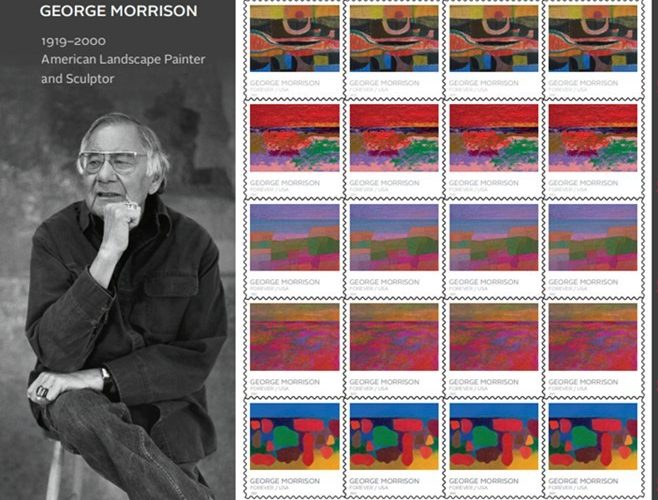U.S. Postal Service pays tribute to Native American modernist George Morrison
(Grand Portage, Mn) — April 22, 2022 — The U.S. Postal Service celebrates the life and work of George Morrison, one of the nation’s greatest modernist artists. Morrison is best known for his abstract landscapes and monumental wood collages that draw on his childhood memories and reflect a deep and abiding connection with the natural world.
“A founding figure of Native American modernism, George Morrison challenged prevailing ideas of what Native American art should be, arguing that an artist’s identity can exist independently from the nature of the art he creates,” said Steve Monteith, chief customer and marketing officer and dedicating official for today’s ceremony at Grand Portage National Monument. “The Postal Service today is honoring Morrison with this pane of 20 stamps featuring five of his abstract landscapes.”
Critical success came early for Morrison, who had his first solo exhibition in New York City in 1948. This exhibition was followed by shows around the country. In 1952, he received a Fulbright scholarship and spent a year studying European art in France. In the decade following his return to the United States, he taught at several schools before joining the faculty at Rhode Island School of Design in 1963.
Morrison remains a leading light of art in Minnesota and of U.S. modernism. In 2004, he was one of two artists featured in the inaugural exhibition at the Smithsonian National Museum of the American Indian in Washington, DC, and a widely lauded retrospective of his work traveled the nation from 2013 through 2015. In 2018, a 200-piece granite mosaic pavement first created by Morrison in 1992 was restored and reinstalled at the popular outdoor shopping and dining mall Nicollet in downtown Minneapolis.
The pane of 20 Forever stamps showcases five of Morrison’s abstract landscapes:
- First row: “Sun and River,” 1949, watercolor and crayon on paper.
- Second row: “Phenomena Against the Crimson: Lake Superior Landscape,” 1985, acrylic on canvas.
- Third row: “Lake Superior Landscape,” 1981, acrylic on canvas.
- Fourth row: “Spirit Path, New Day, Red Rock Variation: Lake Superior Landscape,” 1990, acrylic and pastel on paper.
- Last row: Untitled, 1995, color pencil on paper.
The selvage features a photograph of Morrison at Red Rock, his home and studio in Grand Portage, MN. The art director was Antonio Alcalá. News of the stamps is being shared with the hashtag #GeorgeMorrisonStamps.
Background
George Morrison was born on Sept. 30, 1919, in Chippewa City, MN, a now vanished fishing village on the north shore of Lake Superior. When he was 9 years old, doctors discovered that he had contracted tuberculosis in his left hip, which required surgery and more than a year of recovery, much of it in a full body cast. To pass the time during his long convalescence, he began to draw, displaying a considerable talent. This talent eventually led him in 1938 to the Minneapolis School of Art (now the Minneapolis College of Art and Design). Following graduation in 1943, he moved to New York City and continued his studies at the Art Students League.
Throughout the 1960s, Morrison spent summers on Massachusetts’ Cape Cod, collecting driftwood that he used to create large abstract collages he called “paintings in wood.” Made from pieces of varying color and shape that he fitted together like an intricate puzzle, Morrison’s wood collages are inspired not only by the New England landscape but also by his childhood home on Lake Superior. The knots and whorls of the weather-beaten wood evoke wind and waves, cloud formations, rocky beaches, and the sun or moon. Morrison chose the longest piece of wood to represent a horizon line. The horizon line represents the space where sky and water meet, marking the boundary between known and unknown.
In 1968, one of Morrison’s driftwood collages won the grand prize at the Fourth Invitational Exhibition of Indian Arts and Crafts in Washington, DC, marking a significant turning point in his career. Until then, his work had been rejected for juried exhibitions of Native American art because its style was, in Morrison’s words, “not Indian enough.” By the late 1960s, critical views of what constituted Native American art had begun to broaden, freeing Native artists from preconceived notions of what their work should encompass.
Morrison left Rhode Island in 1970 to teach studio art and Native American studies at the University of Minnesota in Minneapolis. The return to his home state coincided with growing interest in Native American identity across the country. It also contributed to Morrison’s conscious awareness of his own Anishinaabe, or Chippewa, identity even as he continued to refine his modernist vision.
By the mid-1980s, Morrison had retired from teaching and settled in a custom-built studio on the Grand Portage Reservation overlooking Lake Superior, not far from where he had grown up. Poor health prevented him from creating the large-scale pieces he had produced in years past. Nevertheless, he created an astonishing number of works of art in the 1980s and 1990s. Key among them was the Horizon series, a group of small, abstract paintings that capture the ever-changing moods of Lake Superior. Morrison kept working until he died in 2000 at his home on Lake Superior.
Postal Products
Customers may purchase stamps and other philatelic products through the Postal Store at usps.com/shopstamps, by calling 844-737-7826, by mail through USA Philatelic or at Post Office locations nationwide.
The Postal Service generally receives no tax dollars for operating expenses and relies on the sale of postage, products and services to fund its operations.
Please Note: For U.S. Postal Service media resources, including broadcast-quality video and audio and photo stills, visit the USPS Newsroom. Follow us on Twitter, Instagram, Pinterest and LinkedIn. Subscribe to the USPS YouTube channel, like us on Facebook and enjoy our Postal Posts blog. For more information about the Postal Service, visit usps.com and facts.usps.com.



